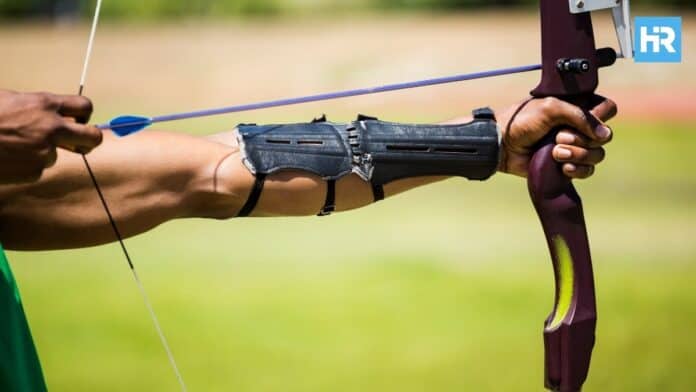Archery is one of the oldest skills people have ever used. It began over 20,000 years ago when early humans made bows and arrows to hunt animals and stay safe. Over time, it was used in wars and later became a sport that people enjoy all around the world.
Today, archery is a global sport featured in the Olympics and Paralympics. The tools and rules have changed, but the core ideas—focus, patience, and skill—remain the same.
In this guide, you’ll learn the full story of archery—from its early days to modern competitions, including the types of bows, famous legends, and how the sport works today.
- Archery, one of the world’s oldest practiced arts, dates back as far as 20,000 BC and has evolved from a survival skill into a globally recognized Olympic sport.
- Legends, including those of Robin Hood and Katniss Everdeen, have helped shape archery’s image and popularity in cultures and media across centuries.
- Modern archery is defined by advanced equipment, precise competition formats, and growing international participation, especially in the Olympic and Paralympic Games.
The Start of Archery: Early Uses and Developments
The earliest signs of archery date back to around 20,000 BC. Archaeologists have found flint arrowheads from this time, showing that people used bows to hunt animals. These early tools helped humans stay safe and increase their chances of catching food.
As societies grew, archery also became useful in battle. Long before guns were invented, bows allowed soldiers to fight from a distance. Archers played a big role in wars across the world, and different regions created their own techniques and equipment.
In Asia, many warriors fought while riding horses. To do this, they used short, curved bows called composite bows made from wood, horn, and sinew. The bows were small and strong—perfect for shooting while moving.
In England during the Middle Ages, soldiers used longbows made of yew wood. The bows were tall, powerful, and required great strength to use. They were used in major battles like Agincourt in 1415, where English archers helped defeat a much larger French army.
As time passed and firearms became more common, archery became less useful in war. Guns were faster and easier to use. But archery didn’t disappear—it became a sport.
One of the earliest recorded archery competitions took place in Finsbury, England, in 1583. This event had 3,000 participants, showing that people still valued archery as a test of skill.
Archery in Culture: Legends and Modern Stories
As archery became part of daily life, it also became part of stories, myths, and legends.
In Greek mythology, the hero Odysseus proved his identity by stringing and shooting a bow that no one else could. In India’s Mahabharata, Arjuna was known as one of the greatest archers, and he was praised for his control and focus.
In China, the legend of Hou Yi tells of an archer who saved the world by shooting down nine suns to stop the earth from burning. In Norse mythology, Ullr was the god of hunting and archery, honored by those who depended on skill and aim to survive.
Japan also has its own famous archer, Nasu no Yoichi. During a battle, he shot an arrow at a small fan placed on a ship and hit it perfectly, becoming legendary for his accuracy.
England’s most well-known archer is Robin Hood. His story dates back to the Middle Ages. He was said to steal from the rich and give to the poor, always carrying his bow and arrows. Today, he remains one of the most famous archers in the world.
In modern times, archery appears in many movies and books. In The Lord of the Rings, Legolas is an elf who never misses. In The Avengers, Hawkeye uses advanced arrows to fight. In The Hunger Games, Katniss Everdeen became a modern symbol of archery, inspiring many young women to pick up a bow.
Archery at the Olympics, Paralympics, and World Games
Archery was first included in the Olympic Games in 1900. It appeared again in 1904, 1908, and 1920. However, after that, it was removed because each country had its own rules, which made fair competition difficult.
Thus, the World Archery Federation was formed in 1931, and its goal was to create one set of rules for everyone. After years of work, archery returned to the Olympics in 1972 and has been part of every Games since.
In today’s Olympics, archers use recurve bows. The competition includes individual, team, and mixed-team events.
In individual events, each archer shoots 72 arrows in the first round. This gives them a ranking. After that, they compete one-on-one in matchplay. Each match has up to five sets, and each set has three arrows. Winning a set gives two points. If both archers tie, they get one point each. The first to reach six points wins the match. If the match is tied after five sets, each archer shoots one arrow. The one closest to the center wins.
Team and mixed-team events follow the same structure but with more arrows. In team events, each team has three archers and shoots six arrows per set. In mixed team events, which were added in Tokyo 2020, each team has one man and one woman, and they shoot four arrows per set.
South Korea is the most successful country in Olympic archery. Their archers have won 32 gold medals, 10 silver medals, and 8 bronze medals. Since 1988, South Korean women have won every Olympic gold in the team event.
Kim Soo-Nyung is the top Olympic archer, with four gold medals, one silver medal, and one bronze. Darrell Pace, from the United States, is the most successful male archer. He won two individual gold medals and one silver team medal.
Archery has also been part of the Paralympic Games since they began in 1960. Dr. Ludwig Guttmann, one of the founders of the Paralympics, used archery as therapy for injured patients at Stoke Mandeville Hospital in England. Para archers use recurve or compound bows, depending on their classification.
Archery was added to the World Games in 1985. These games include sports not always seen in the Olympics. At first, only recurve and barebow archers competed in field archery. Compound bows were added in 1995.
In 2013, compound events moved to target archery. Morgan Lundin is the most successful World Games archer. He won gold in the compound men’s field event in 1993, 1997, and 2005.
Modern Archery: Disciplines and Equipment
Today, archery is practiced in many different ways. The most common form is target archery, which is also the type used in the Olympics.
In this format, archers shoot arrows at a round target with five colored rings: gold, red, blue, black, and white. Each color has different point values. The gold rings in the center score the highest—10 and 9 points. Red scores 8 and 7, blue scores 6 and 5, black scores 4 and 3, and white scores 2 and 1.
Olympic recurve archers shoot from a distance of 70 meters. Compound archers, who are not part of the Olympics but compete in other international events, shoot from 50 meters. Barebow and longbow archers also participate in target competitions, usually at shorter distances, but in some events, longbowmen can shoot as far as 90 meters.
Another type is indoor archery, which is similar to target archery but takes place inside a building. The distance is shorter—usually 18 meters. The World Archery Indoor Championships were held from 1991 to 2018. Now, indoor competitions continue as part of the Indoor Archery World Series.
There is also field archery, which takes place outdoors on natural terrain like forests or hills. Archers walk through a course and shoot at targets placed at different distances, angles, and heights. Field archery tests also measure how well archers can judge distance, shoot uphill or downhill, and adapt to changing light and wind. The World Archery Field Championships are held every two years. The first one took place in 1969.
Archery has several different types of bows, and each type is used in different ways:
- The recurve bow is the only type allowed in the Olympic Games. It is shaped with tips that curve away from the archer, which gives it more power. Modern recurve bows are made with strong, light materials like carbon fiber and aluminum. They also have extra parts like sights for aiming and stabilizers to keep the bow steady when shooting. Arrows from a recurve bow can travel over 200 kilometers per hour.
- The compound bow, created in the 1960s, uses a system of pulleys and cables. This design reduces the amount of strength needed to hold the bow at full draw, making it easier to aim carefully. Compound bows are very accurate and often have magnifying sights and release aids that help with precision. They are not used in the Olympics but are part of many other international events, like the World Games and the Archery World Cup.
- The barebow is a simpler version of the recurve bow. It does not have sights, stabilizers, or other extra parts. Because of this, barebow archers rely more on instinct and consistent form. Barebow is used in both target and field archery and has become more popular in recent years.
- The longbow is the most traditional type of bow. It has been used in the UK for thousands of years, especially during the Middle Ages. These bows are tall and made of wood, often yew, although today, some are made with more sustainable materials like bamboo. If a longbow is made from modern materials like carbon, it is called an American flatbow. Longbows do not have sights or stabilizers, and shooting them requires a strong and steady hand.
There are a few other types of bows as well.
Horse bows are small and curved, based on those used by warriors in Asia and the Middle East. They are designed for use on horseback.
Crossbows differ from other bows—they are held horizontally, and a trigger is used to shoot bolts. Crossbows have their own competitions but do not compete alongside other bow types.
In some countries, especially the UK, bowhunting is illegal, meaning you cannot use bows to hunt animals. In the UK, archery is only allowed as a sport, not for hunting.






